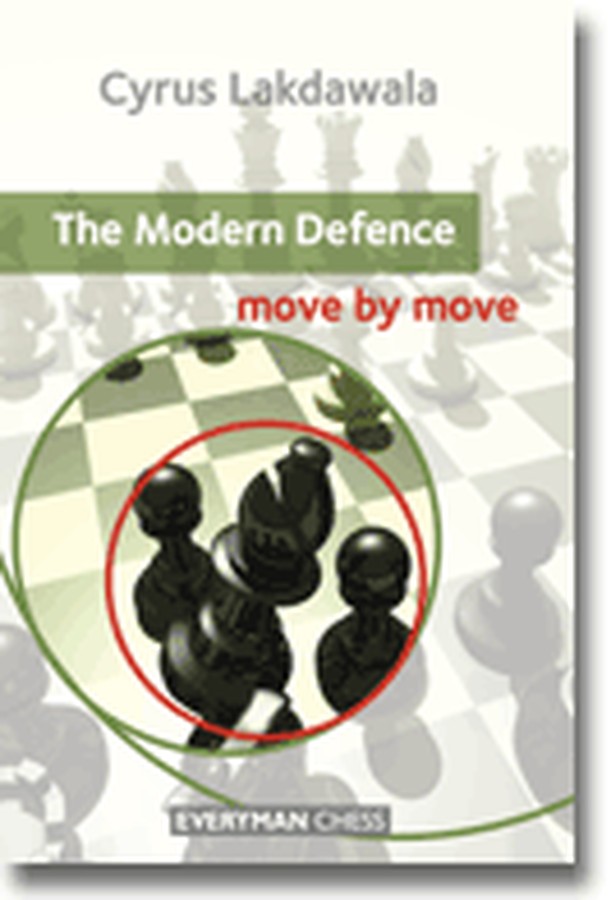| Nivå | B-D |
| Utgivelsesdato | September 2012 |
| Forfatter | |
| Pris | 280 NOK |
The Modern Defence move by move
Turen har kommet til "Moderne forsvar" i denne populære serien. En innholdsrik bok på hele 400 sider med utgangspunkt i 1 e4 g6, men den behandler også svarts spill mot 1 d4 og 1 c4.
Dette er instruktive åpningsbøker som det også er "forbausende hyggelig å lese"! Mange av disse partiene i "Moderne forsvar" er dessuten usedvanlig lekre saker.
Boka er i noen grad en direkte oppfølging av Tiger Hillarp Perssons sukessbok "Tiger's Modern", da Lakdawala i basisvarianter med 1 e4 g6 2 d4 Lg7 3 Sc3 d6 angir partier med det moderne 4... a6 etter både 4 Sf3, 4 Le3 og 4 f4.
Starten på forfatterens introduksjon
I recall a game I played during a lunch break in seventh grade against one of the history teachers. He opened with 1 e4. At the time I read Canadian Chess Chat magazine, which was permeated with the games of Canada’s chess god, Duncan Suttles, who opened 1...g6! on every white first move.
Now from my rudimentary understanding, I reasoned that there was no higher chess authority than Suttles, so like a faithful acolyte I dutifully followed suit and played 1...g6!. The history teacher closed his eyes and nodded wisely, as if confirming some long-held suspicion about my intelligence level. Then he issued this ominous prediction: “You have just lost the game!” “Why!?” I whined vehemently. The wise teacher went on to explain: “Both players should fight for the centre of the board, therefore 1...g6 is a weak move which hands White central control.”
Even then, intuition warned me that something was off with the teacher’s bogus assessment. Forty years later, I confidently assert that the teacher was wrong, and the Modern Defence is sound, and the stats are there to prove it. Luckily, I didn’t believe him and play the Modern to this day.
The Modern is indeed a scary, counter-intuitive opening and the rules which govern are quite distinct from those in other, more orthodox openings. We Modernists view life on the chess board with extraterrestrial, alien perception. After all, as the teacher pointed out, Black, in hypermodern fashion, cedes White central control without a fight. But giving away the centre is not done with a motivation of generosity or trepidation. The plan is to later chip away at White’s centre from the sides and tear it down.
The second scary issue people have with the Modern (as John Watson once pointed out) is the fact that many of the lines look similar, except for some minute, imperceptible shift, and that one tiny shift may completely alter your strategy from the other look-alike variation. The structure alters in astonishingly disorienting ways, like some alien shape shifter, who appears differently each day. Both we and our opponents walk theoretical corridors on unsteady legs, but this is not such a big problem if you think about it. Have you ever eaten a curry so hot that there actually is no taste except for the allencompassing bonfire in your mouth (I am Indian and have endured this experience many, many times)? The Modern is a bit like this: it is so complicated that it is easy to play! If chaos and complexity increase past the limits of the understanding of most club players – or even GMs for that matter – the participants basically tend to play by feel. This in turn means that the Modern player is accustomed to such chaos, while White encounters it rarely and is often left groping about for the right plan.
If you just go through the games of this book and study the great Modernists and post- Modernists, like: Duncan Suttles, Ray Keene, Jon Speelman, Nigel Davies, Colin McNab, Tiger Hillarp Person, Zurab Azmaiparashvili and Peter Svidler, I bet you will not be overwhelmed and boggled by the complexity, unlike many of your unfortunate opponents, who don’t encounter Modern all that often.
The Mechanics of the Modern Defence
Unlike classical, solid opening lines like 1 e4 e5, the Caro-Kann, or the Queen’s Gambit Declined, the Modern doesn’t fight for central control, or solidity, or even seek to equalize. We begin asymmetrically and challenge White from our very first move. For years I endured from lower-rated players playing White, the Exchange Slav and the Exchange French, both with the intent to take the life out of positions, and allow my lower-rated opponents to deaden the position and draw.A few years back I got tired of this weasely strategy from my more cowardly opponents and added my childhood favourite 1...g6 against any first move. I noticed with shock that after a year my stats were actually equal to or better than with the Slav, the Caro-Kann, the French and the Sicilian. The number of draws went way down, and my losses in turn thankfully did not increase (too much at least!). I am normally associated with super-solid lines like the Slav and Caro, but now add 1...g6 (and the Modern’s introverted brother 1...d6) as one of my main openings as Black.
Innhold
007 Series Foreword
008 Bibliography
009 Introduction
017 1. The Pseudo Dragon
059 2. Classical Lines from White
112 3. The Austrian Attack
165 4. To Nowhere: 4 Bg5
186 5. Bc4 Cro-Magnon Lines
210 6. The Fianchetto Line
231 7. Coward’s Variation
266 8. Odds and Ends
288 9. The Averbakh Variation
331 10. Offbeat Averbakh Lines
355 11. Anti-Queen’s Pawn Lines
373 12. The English
392 Index of Variations
399 Index of Complete Games
| Innbundet? | Nei |
| Type | Bok |
| Språk | Engelsk |
| Antall sider | 400 |
Produktet er en del av serien Move by Move åpningsbøker
En ny og annerledes serie av åpningsbøker som startet i 2011. Åpningene blir gjennomgått grundig med spørsmål og svar som engasjerer leseren mer direkte i prosesssen gjennom hvert parti. Det er i hovedsak repertoarbøker med instruktive og stor grad ferske partieksempler.
Se også
-

Starting Out: The Modern
KjøpNigel Davies er selv en spesialist på "Moderne forsvar", det å starte med g6 og Lg7 i prinspippet uansett hvits trekk, og siden kunne velge mellom ulike angrep mot hvits valgte oppstilling. Fiffig sjakk. Dette blir i praksis en fleksibel repertoar- og idebok med fine partier særlig fra svarts side. Hovedtyngden er spill mot 1 e4, men boka har også spill mot d4-åpning fra hvit (med c4) og til og med litt mot flankeåpning med 1 Sf3 eller c4.
- Pris
- 225
- Nivå
- B-D
- Av
- Utgivelsesdato
- Juni 2008

